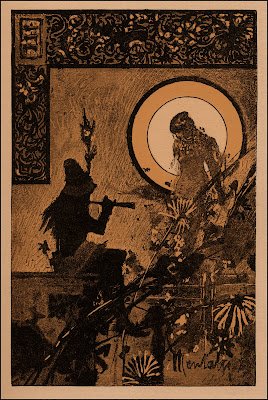This drawing by Alfredo Montalti (1858-1928) is originally from C'era una Volta, a book of Italian fairy tales, published in Milan in 1885. This scan is from a rescued page from a decimated L'illustration periodical, carefully kept in my image morgue for many years. I was happy to find reference to it in Pen Drawing and Pen Draughtsmen by Joseph Pennell.
Pennell's book, originally published in 1889, has been reprinted a number of times, and is interesting, not just for the variety of old ink drawings, but also for Pennell's forthright and candid opinions on this artist or that. He especially is derisive of 'modern' illustration techniques (which to our time seems wonderfully classic). But he likes this drawing.
". . . this is an example of decoration applied to book illustration. Not only does it illustrate a passage in the story, but it is given with the greatest amount of decorative feeling, and in a style which proves that there is no reason why we should be dependent on the decorative methods of other times save to carry on tradition. Conventional forms are the property of the world. it may be argued that there is no meaning in this decoration. Neither to me—and I am sure I speak for all artists who are honest—is there meaning in nearly all decoration except that of pleasure in the beauty of the design. We may be told in Smith's Classical Dictionary, or in any of those useful cribs much affected by the cultured uplift artist, that such and such mysterious swirls and scrawls mean life and immortality, but we are not impressed by this hidden meaning; we only look to see if the line is well drawn—we do, but most do not; they are impressed with the details which have nothing to do with it at all.
Montalti's decorations at the side and top of his drawing are graceful. They many have been derived from old iron-work or from his inner consciousness. The result is pleasing and restful. The white circle behind the girl may be a swirl of life or the bull's eye of a target; it really is a proof that Montalti is an illustrator who knows the requirements of his art. He had used this white circle for his mass of light which draws attention to the figure of the girl; the figure of the piping shepherd is his great black, and the positive black and white neutralize each other. It also may be said that the half-decorative, half-realistic daisies at the bottom of the drawing are out of place: nothing is out of place in art if the result is good, and it is nobody's business but the artist's how it is obtained. . ."



1 comment:
For some reason, the illustration reminds me of the images in a graphic novel by Neil Gaiman, Sandman: Dream Hunters, based on Japanese fairy tales.
http://en.wikipedia.org/wiki/The_Dream_Hunters
Post a Comment